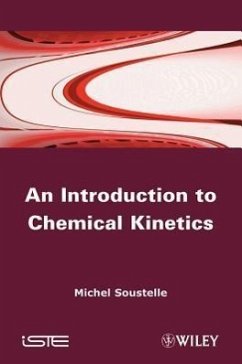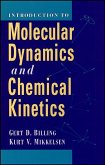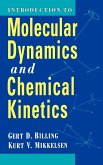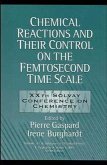Michel Soustelle
An Introduction to Chemical Kinetics
Michel Soustelle
An Introduction to Chemical Kinetics
- Gebundenes Buch
- Merkliste
- Auf die Merkliste
- Bewerten Bewerten
- Teilen
- Produkt teilen
- Produkterinnerung
- Produkterinnerung
"Adapted and updated from Cinetique chimique: elements fondamentaux & Mecanismes reactionnels et cinetique chimique published 2011 in France by Hermes Science/Lavoisier."
Andere Kunden interessierten sich auch für
![Introduction to Molecular Dynamics and Chemical Kinetics & Advanced Molecular Dynamics and Chemical Kinetics, 2 Volume Set Introduction to Molecular Dynamics and Chemical Kinetics & Advanced Molecular Dynamics and Chemical Kinetics, 2 Volume Set]() Gert Due BillingIntroduction to Molecular Dynamics and Chemical Kinetics & Advanced Molecular Dynamics and Chemical Kinetics, 2 Volume Set345,99 €
Gert Due BillingIntroduction to Molecular Dynamics and Chemical Kinetics & Advanced Molecular Dynamics and Chemical Kinetics, 2 Volume Set345,99 €![Chemical Kinetics Chemical Kinetics]() Kenneth A ConnorsChemical Kinetics355,99 €
Kenneth A ConnorsChemical Kinetics355,99 €![Introduction to Chemical Kinetics Introduction to Chemical Kinetics]() Margaret Robson WrightIntroduction to Chemical Kinetics102,99 €
Margaret Robson WrightIntroduction to Chemical Kinetics102,99 €![Introduction to Molecular Dynamics and Chemical Kinetics Introduction to Molecular Dynamics and Chemical Kinetics]() Gert Due BillingIntroduction to Molecular Dynamics and Chemical Kinetics221,99 €
Gert Due BillingIntroduction to Molecular Dynamics and Chemical Kinetics221,99 €![Advances in Chemical Physics, Volume 148 Advances in Chemical Physics, Volume 148]() Advances in Chemical Physics, Volume 148270,99 €
Advances in Chemical Physics, Volume 148270,99 €![Advances in Chemical Physics, Volume 114 Advances in Chemical Physics, Volume 114]() Advances in Chemical Physics, Volume 114472,99 €
Advances in Chemical Physics, Volume 114472,99 €![Chemical Reactions and Their Control on the Femtosecond Time Scale Chemical Reactions and Their Control on the Femtosecond Time Scale]() Chemical Reactions and Their Control on the Femtosecond Time Scale520,99 €
Chemical Reactions and Their Control on the Femtosecond Time Scale520,99 €-
-
-
"Adapted and updated from Cinetique chimique: elements fondamentaux & Mecanismes reactionnels et cinetique chimique published 2011 in France by Hermes Science/Lavoisier."
Hinweis: Dieser Artikel kann nur an eine deutsche Lieferadresse ausgeliefert werden.
Hinweis: Dieser Artikel kann nur an eine deutsche Lieferadresse ausgeliefert werden.
Produktdetails
- Produktdetails
- Verlag: Wiley
- Seitenzahl: 480
- Erscheinungstermin: 12. Juli 2011
- Englisch
- Abmessung: 246mm x 164mm x 33mm
- Gewicht: 816g
- ISBN-13: 9781848213029
- ISBN-10: 1848213026
- Artikelnr.: 33670839
- Herstellerkennzeichnung
- Libri GmbH
- Europaallee 1
- 36244 Bad Hersfeld
- gpsr@libri.de
- Verlag: Wiley
- Seitenzahl: 480
- Erscheinungstermin: 12. Juli 2011
- Englisch
- Abmessung: 246mm x 164mm x 33mm
- Gewicht: 816g
- ISBN-13: 9781848213029
- ISBN-10: 1848213026
- Artikelnr.: 33670839
- Herstellerkennzeichnung
- Libri GmbH
- Europaallee 1
- 36244 Bad Hersfeld
- gpsr@libri.de
Michel Soustelle is a chemical engineer and Emeritus Professor at Ecole des Mines de Saint-Etienne in France. He taught chemical kinetics from postgraduate to Master's levels while also carrying out research in this topic.
Preface xvii
PART 1. BASIC CONCEPTS OF CHEMICAL KINETICS 1
Chapter 1. Chemical Reaction and Kinetic Quantities 3
1.1. The chemical reaction 3
1.2. Homogeneous and heterogeneous reactions 8
1.3. Extent and speed of a reaction 9
1.4. Volumetric and areal speed of a monozone reaction 12
1.5. Fractional extent and rate of a reaction 14
1.6. Reaction speeds and concentrations 18
1.7. Expression of volumetric speed according to variations in
concentration in a closed system 19
1.8. Stoichiometric mixtures and progress 20
1.9. Factors influencing reaction speeds 21
Chapter 2. Reaction Mechanisms and Elementary Steps 25
2.1. Basic premise of kinetics 25
2.2. Reaction mechanism 26
2.3. Reaction intermediates 29
2.4. Reaction sequences and Semenov representation 32
2.5. Chain reactions 34
2.6. Catalytic reactions 37
2.7. Important figures in reaction mechanisms 41
Chapter 3. Kinetic Properties of Elementary Reactions 43
3.1. Space function of an elementary reaction 43
3.2. Reactivity and rate of an elementary step 44
3.3. Kinetic constants of an elementary step 45
3.4. Opposite elementary reactions 47
3.5. Influence of temperature on the reactivities of elementary steps 49
3.6. Modeling of a gas phase elementary step 51
3.7. A particular elementary step: diffusion 58
3.8. Gases adsorption onto solids 64
3.9. Important figures in the kinetic properties of elementary reactions 71
Chapter 4. Kinetic Data Acquisition 73
4.1. Experimental kinetic data of a reaction 73
4.2. Generalities on measuring methods 74
4.3. Chemical methods 74
4.4. Physical methods 75
4.5. Researching the influence of various variables 87
Chapter 5. Experimental Laws and Calculation of Kinetic Laws of Homogeneous
Systems 91
5.1. Experimental laws in homogeneous kinetics 91
5.2. Relationship between the speed of a reaction and the speeds of its
elementary steps 95
5.3. Mathematical formulation of speed from a mechanism and experimental
conditions 96
5.4. Mathematical formulation of a homogeneous reaction with open sequence
99
5.5. Mathematical formulation of chain reactions 101
Chapter 6. Experimental Data and Calculation of Kinetic Laws of
Heterogeneous Reactions 109
6.1. Heterogeneous reactions 109
6.2. Experimental kinetic data of heterogeneous reactions 112
6.3. Involvement of diffusion in matter balances 119
6.4. Example of mathematical formulation of a heterogeneous catalytic
reaction 124
6.5. Example of the mathematical formulation of an evolution process of a
phase 127
Chapter 7. Pseudo- and Quasi-steady State Modes 135
7.1. Pseudo-steady state mode 135
7.2. Pseudo-steady state sequences with constant volume (or surface) -
quasi-steady state 147
7.3. Pseudo- and quasi-steady state of diffusion 150
7.4. Application to the calculation of speeds in pseudo-steady state or
quasi-steady state 151
7.5. Pseudo-steady state and open or closed systems 159
7.6. Conclusion 162
7.7. Important figure in pseudo-steady state 163
Chapter 8. Modes with Rate-determining Steps 165
8.1. Mode with one determining step 166
8.2. Pseudo-steady state mode with two determining steps 185
8.3. Generalization to more than two determining steps 189
8.4. Conclusion to the study of modes with one or several rate-determining
steps 190
8.5. First order mode changes 190
8.6. Conclusion 191
PART 2. REACTION MECHANISMS AND KINETIC PROPERTIES 193
Chapter 9. Establishment and Resolution of a Reaction Mechanism 195
9.1. Families of reaction mechanisms 195
9.2. Different categories of elementary steps 196
9.3. Establishment of a reaction mechanism 201
9.4. Research into a mechanism: intermediary reactions 205
9.5. Back to the modes and laws of kinetics 210
9.6. Experimental tests 212
9.7. Looking for the type of rate law 218
Chapter 10. Theory of the Activated Complex in the Gas Phase 223
10.1. The notion of molecular energy: the energy of a group of atoms 223
10.2. Bimolecular reactions in the gas phase 227
10.3. Monomolecular reactions in the gas phase 243
10.4. Photochemical elementary reactions 248
10.5. The theory of activated complexes 252
Chapter 11. Modeling Elementary Reactions in Condensed Phase 253
11.1. Elementary reaction in the liquid phase 253
11.2. Elementary reaction in the solid state 268
11.3. Interphase reactions 276
11.4. Electrochemical reactions 280
11.5. Conclusion 290
Chapter 12. The Kinetics of Chain Reactions 291
12.1. Definition of a chain reaction 291
12.2. The kinetic characteristics of chain reactions 292
12.3. Classification of chain reactions 293
12.4. Chain reaction sequences 295
12.5. Kinetic study of straight chain or non-branch chain reactions 299
12.6. Kinetic study of chain reactions with direct branching 311
12.7. Semenov and the kinetics of chain reactions 321
Chapter 13. Catalysis and Catalyzed Reactions 323
13.1. Homogenous catalysis 324
13.2. Heterogeneous catalysis reactions 335
13.3. Gas-solid reactions leading to a gas 351
13.4. Conclusion on catalysis 352
13.5. Langmiur and Hinshelwood 352
Chapter 14. Kinetics of Heterogeneous Stoichiometric Reactions 353
14.1. Extent versus time and rate versus extent curves 354
14.2. The global model with two processes 355
14.3. The ?ÖE law 356
14.4. Morphological modeling of the growing space function 357
14.5. The nucleation process 373
14.6. Physico-chemical growth models 384
14.7. Conclusion on heterogeneous reactions 386
14.8. Important figures in reaction kinetics 387
Chapter 15. Kinetics of Non-pseudo-steady State Modes 389
15.1. Partial pseudo-steady state modes 389
15.2. The paralinear law of metal oxidation 392
15.3. Thermal runaway and ignition of reactions 395
15.4. Chemical ignition of gaseous mixtures 397
APPENDICES 405
Appendix 1. Point Defects and Structure Elements of Solids 407
Appendix 2. Notions of Microscopic Thermodynamics 413
Appendix 3. Vibration Frequency of the Activated Complex 425
Notations and Symbols 431
Bibliography 439
Index 441
PART 1. BASIC CONCEPTS OF CHEMICAL KINETICS 1
Chapter 1. Chemical Reaction and Kinetic Quantities 3
1.1. The chemical reaction 3
1.2. Homogeneous and heterogeneous reactions 8
1.3. Extent and speed of a reaction 9
1.4. Volumetric and areal speed of a monozone reaction 12
1.5. Fractional extent and rate of a reaction 14
1.6. Reaction speeds and concentrations 18
1.7. Expression of volumetric speed according to variations in
concentration in a closed system 19
1.8. Stoichiometric mixtures and progress 20
1.9. Factors influencing reaction speeds 21
Chapter 2. Reaction Mechanisms and Elementary Steps 25
2.1. Basic premise of kinetics 25
2.2. Reaction mechanism 26
2.3. Reaction intermediates 29
2.4. Reaction sequences and Semenov representation 32
2.5. Chain reactions 34
2.6. Catalytic reactions 37
2.7. Important figures in reaction mechanisms 41
Chapter 3. Kinetic Properties of Elementary Reactions 43
3.1. Space function of an elementary reaction 43
3.2. Reactivity and rate of an elementary step 44
3.3. Kinetic constants of an elementary step 45
3.4. Opposite elementary reactions 47
3.5. Influence of temperature on the reactivities of elementary steps 49
3.6. Modeling of a gas phase elementary step 51
3.7. A particular elementary step: diffusion 58
3.8. Gases adsorption onto solids 64
3.9. Important figures in the kinetic properties of elementary reactions 71
Chapter 4. Kinetic Data Acquisition 73
4.1. Experimental kinetic data of a reaction 73
4.2. Generalities on measuring methods 74
4.3. Chemical methods 74
4.4. Physical methods 75
4.5. Researching the influence of various variables 87
Chapter 5. Experimental Laws and Calculation of Kinetic Laws of Homogeneous
Systems 91
5.1. Experimental laws in homogeneous kinetics 91
5.2. Relationship between the speed of a reaction and the speeds of its
elementary steps 95
5.3. Mathematical formulation of speed from a mechanism and experimental
conditions 96
5.4. Mathematical formulation of a homogeneous reaction with open sequence
99
5.5. Mathematical formulation of chain reactions 101
Chapter 6. Experimental Data and Calculation of Kinetic Laws of
Heterogeneous Reactions 109
6.1. Heterogeneous reactions 109
6.2. Experimental kinetic data of heterogeneous reactions 112
6.3. Involvement of diffusion in matter balances 119
6.4. Example of mathematical formulation of a heterogeneous catalytic
reaction 124
6.5. Example of the mathematical formulation of an evolution process of a
phase 127
Chapter 7. Pseudo- and Quasi-steady State Modes 135
7.1. Pseudo-steady state mode 135
7.2. Pseudo-steady state sequences with constant volume (or surface) -
quasi-steady state 147
7.3. Pseudo- and quasi-steady state of diffusion 150
7.4. Application to the calculation of speeds in pseudo-steady state or
quasi-steady state 151
7.5. Pseudo-steady state and open or closed systems 159
7.6. Conclusion 162
7.7. Important figure in pseudo-steady state 163
Chapter 8. Modes with Rate-determining Steps 165
8.1. Mode with one determining step 166
8.2. Pseudo-steady state mode with two determining steps 185
8.3. Generalization to more than two determining steps 189
8.4. Conclusion to the study of modes with one or several rate-determining
steps 190
8.5. First order mode changes 190
8.6. Conclusion 191
PART 2. REACTION MECHANISMS AND KINETIC PROPERTIES 193
Chapter 9. Establishment and Resolution of a Reaction Mechanism 195
9.1. Families of reaction mechanisms 195
9.2. Different categories of elementary steps 196
9.3. Establishment of a reaction mechanism 201
9.4. Research into a mechanism: intermediary reactions 205
9.5. Back to the modes and laws of kinetics 210
9.6. Experimental tests 212
9.7. Looking for the type of rate law 218
Chapter 10. Theory of the Activated Complex in the Gas Phase 223
10.1. The notion of molecular energy: the energy of a group of atoms 223
10.2. Bimolecular reactions in the gas phase 227
10.3. Monomolecular reactions in the gas phase 243
10.4. Photochemical elementary reactions 248
10.5. The theory of activated complexes 252
Chapter 11. Modeling Elementary Reactions in Condensed Phase 253
11.1. Elementary reaction in the liquid phase 253
11.2. Elementary reaction in the solid state 268
11.3. Interphase reactions 276
11.4. Electrochemical reactions 280
11.5. Conclusion 290
Chapter 12. The Kinetics of Chain Reactions 291
12.1. Definition of a chain reaction 291
12.2. The kinetic characteristics of chain reactions 292
12.3. Classification of chain reactions 293
12.4. Chain reaction sequences 295
12.5. Kinetic study of straight chain or non-branch chain reactions 299
12.6. Kinetic study of chain reactions with direct branching 311
12.7. Semenov and the kinetics of chain reactions 321
Chapter 13. Catalysis and Catalyzed Reactions 323
13.1. Homogenous catalysis 324
13.2. Heterogeneous catalysis reactions 335
13.3. Gas-solid reactions leading to a gas 351
13.4. Conclusion on catalysis 352
13.5. Langmiur and Hinshelwood 352
Chapter 14. Kinetics of Heterogeneous Stoichiometric Reactions 353
14.1. Extent versus time and rate versus extent curves 354
14.2. The global model with two processes 355
14.3. The ?ÖE law 356
14.4. Morphological modeling of the growing space function 357
14.5. The nucleation process 373
14.6. Physico-chemical growth models 384
14.7. Conclusion on heterogeneous reactions 386
14.8. Important figures in reaction kinetics 387
Chapter 15. Kinetics of Non-pseudo-steady State Modes 389
15.1. Partial pseudo-steady state modes 389
15.2. The paralinear law of metal oxidation 392
15.3. Thermal runaway and ignition of reactions 395
15.4. Chemical ignition of gaseous mixtures 397
APPENDICES 405
Appendix 1. Point Defects and Structure Elements of Solids 407
Appendix 2. Notions of Microscopic Thermodynamics 413
Appendix 3. Vibration Frequency of the Activated Complex 425
Notations and Symbols 431
Bibliography 439
Index 441
Preface xvii
PART 1. BASIC CONCEPTS OF CHEMICAL KINETICS 1
Chapter 1. Chemical Reaction and Kinetic Quantities 3
1.1. The chemical reaction 3
1.2. Homogeneous and heterogeneous reactions 8
1.3. Extent and speed of a reaction 9
1.4. Volumetric and areal speed of a monozone reaction 12
1.5. Fractional extent and rate of a reaction 14
1.6. Reaction speeds and concentrations 18
1.7. Expression of volumetric speed according to variations in
concentration in a closed system 19
1.8. Stoichiometric mixtures and progress 20
1.9. Factors influencing reaction speeds 21
Chapter 2. Reaction Mechanisms and Elementary Steps 25
2.1. Basic premise of kinetics 25
2.2. Reaction mechanism 26
2.3. Reaction intermediates 29
2.4. Reaction sequences and Semenov representation 32
2.5. Chain reactions 34
2.6. Catalytic reactions 37
2.7. Important figures in reaction mechanisms 41
Chapter 3. Kinetic Properties of Elementary Reactions 43
3.1. Space function of an elementary reaction 43
3.2. Reactivity and rate of an elementary step 44
3.3. Kinetic constants of an elementary step 45
3.4. Opposite elementary reactions 47
3.5. Influence of temperature on the reactivities of elementary steps 49
3.6. Modeling of a gas phase elementary step 51
3.7. A particular elementary step: diffusion 58
3.8. Gases adsorption onto solids 64
3.9. Important figures in the kinetic properties of elementary reactions 71
Chapter 4. Kinetic Data Acquisition 73
4.1. Experimental kinetic data of a reaction 73
4.2. Generalities on measuring methods 74
4.3. Chemical methods 74
4.4. Physical methods 75
4.5. Researching the influence of various variables 87
Chapter 5. Experimental Laws and Calculation of Kinetic Laws of Homogeneous
Systems 91
5.1. Experimental laws in homogeneous kinetics 91
5.2. Relationship between the speed of a reaction and the speeds of its
elementary steps 95
5.3. Mathematical formulation of speed from a mechanism and experimental
conditions 96
5.4. Mathematical formulation of a homogeneous reaction with open sequence
99
5.5. Mathematical formulation of chain reactions 101
Chapter 6. Experimental Data and Calculation of Kinetic Laws of
Heterogeneous Reactions 109
6.1. Heterogeneous reactions 109
6.2. Experimental kinetic data of heterogeneous reactions 112
6.3. Involvement of diffusion in matter balances 119
6.4. Example of mathematical formulation of a heterogeneous catalytic
reaction 124
6.5. Example of the mathematical formulation of an evolution process of a
phase 127
Chapter 7. Pseudo- and Quasi-steady State Modes 135
7.1. Pseudo-steady state mode 135
7.2. Pseudo-steady state sequences with constant volume (or surface) -
quasi-steady state 147
7.3. Pseudo- and quasi-steady state of diffusion 150
7.4. Application to the calculation of speeds in pseudo-steady state or
quasi-steady state 151
7.5. Pseudo-steady state and open or closed systems 159
7.6. Conclusion 162
7.7. Important figure in pseudo-steady state 163
Chapter 8. Modes with Rate-determining Steps 165
8.1. Mode with one determining step 166
8.2. Pseudo-steady state mode with two determining steps 185
8.3. Generalization to more than two determining steps 189
8.4. Conclusion to the study of modes with one or several rate-determining
steps 190
8.5. First order mode changes 190
8.6. Conclusion 191
PART 2. REACTION MECHANISMS AND KINETIC PROPERTIES 193
Chapter 9. Establishment and Resolution of a Reaction Mechanism 195
9.1. Families of reaction mechanisms 195
9.2. Different categories of elementary steps 196
9.3. Establishment of a reaction mechanism 201
9.4. Research into a mechanism: intermediary reactions 205
9.5. Back to the modes and laws of kinetics 210
9.6. Experimental tests 212
9.7. Looking for the type of rate law 218
Chapter 10. Theory of the Activated Complex in the Gas Phase 223
10.1. The notion of molecular energy: the energy of a group of atoms 223
10.2. Bimolecular reactions in the gas phase 227
10.3. Monomolecular reactions in the gas phase 243
10.4. Photochemical elementary reactions 248
10.5. The theory of activated complexes 252
Chapter 11. Modeling Elementary Reactions in Condensed Phase 253
11.1. Elementary reaction in the liquid phase 253
11.2. Elementary reaction in the solid state 268
11.3. Interphase reactions 276
11.4. Electrochemical reactions 280
11.5. Conclusion 290
Chapter 12. The Kinetics of Chain Reactions 291
12.1. Definition of a chain reaction 291
12.2. The kinetic characteristics of chain reactions 292
12.3. Classification of chain reactions 293
12.4. Chain reaction sequences 295
12.5. Kinetic study of straight chain or non-branch chain reactions 299
12.6. Kinetic study of chain reactions with direct branching 311
12.7. Semenov and the kinetics of chain reactions 321
Chapter 13. Catalysis and Catalyzed Reactions 323
13.1. Homogenous catalysis 324
13.2. Heterogeneous catalysis reactions 335
13.3. Gas-solid reactions leading to a gas 351
13.4. Conclusion on catalysis 352
13.5. Langmiur and Hinshelwood 352
Chapter 14. Kinetics of Heterogeneous Stoichiometric Reactions 353
14.1. Extent versus time and rate versus extent curves 354
14.2. The global model with two processes 355
14.3. The ?ÖE law 356
14.4. Morphological modeling of the growing space function 357
14.5. The nucleation process 373
14.6. Physico-chemical growth models 384
14.7. Conclusion on heterogeneous reactions 386
14.8. Important figures in reaction kinetics 387
Chapter 15. Kinetics of Non-pseudo-steady State Modes 389
15.1. Partial pseudo-steady state modes 389
15.2. The paralinear law of metal oxidation 392
15.3. Thermal runaway and ignition of reactions 395
15.4. Chemical ignition of gaseous mixtures 397
APPENDICES 405
Appendix 1. Point Defects and Structure Elements of Solids 407
Appendix 2. Notions of Microscopic Thermodynamics 413
Appendix 3. Vibration Frequency of the Activated Complex 425
Notations and Symbols 431
Bibliography 439
Index 441
PART 1. BASIC CONCEPTS OF CHEMICAL KINETICS 1
Chapter 1. Chemical Reaction and Kinetic Quantities 3
1.1. The chemical reaction 3
1.2. Homogeneous and heterogeneous reactions 8
1.3. Extent and speed of a reaction 9
1.4. Volumetric and areal speed of a monozone reaction 12
1.5. Fractional extent and rate of a reaction 14
1.6. Reaction speeds and concentrations 18
1.7. Expression of volumetric speed according to variations in
concentration in a closed system 19
1.8. Stoichiometric mixtures and progress 20
1.9. Factors influencing reaction speeds 21
Chapter 2. Reaction Mechanisms and Elementary Steps 25
2.1. Basic premise of kinetics 25
2.2. Reaction mechanism 26
2.3. Reaction intermediates 29
2.4. Reaction sequences and Semenov representation 32
2.5. Chain reactions 34
2.6. Catalytic reactions 37
2.7. Important figures in reaction mechanisms 41
Chapter 3. Kinetic Properties of Elementary Reactions 43
3.1. Space function of an elementary reaction 43
3.2. Reactivity and rate of an elementary step 44
3.3. Kinetic constants of an elementary step 45
3.4. Opposite elementary reactions 47
3.5. Influence of temperature on the reactivities of elementary steps 49
3.6. Modeling of a gas phase elementary step 51
3.7. A particular elementary step: diffusion 58
3.8. Gases adsorption onto solids 64
3.9. Important figures in the kinetic properties of elementary reactions 71
Chapter 4. Kinetic Data Acquisition 73
4.1. Experimental kinetic data of a reaction 73
4.2. Generalities on measuring methods 74
4.3. Chemical methods 74
4.4. Physical methods 75
4.5. Researching the influence of various variables 87
Chapter 5. Experimental Laws and Calculation of Kinetic Laws of Homogeneous
Systems 91
5.1. Experimental laws in homogeneous kinetics 91
5.2. Relationship between the speed of a reaction and the speeds of its
elementary steps 95
5.3. Mathematical formulation of speed from a mechanism and experimental
conditions 96
5.4. Mathematical formulation of a homogeneous reaction with open sequence
99
5.5. Mathematical formulation of chain reactions 101
Chapter 6. Experimental Data and Calculation of Kinetic Laws of
Heterogeneous Reactions 109
6.1. Heterogeneous reactions 109
6.2. Experimental kinetic data of heterogeneous reactions 112
6.3. Involvement of diffusion in matter balances 119
6.4. Example of mathematical formulation of a heterogeneous catalytic
reaction 124
6.5. Example of the mathematical formulation of an evolution process of a
phase 127
Chapter 7. Pseudo- and Quasi-steady State Modes 135
7.1. Pseudo-steady state mode 135
7.2. Pseudo-steady state sequences with constant volume (or surface) -
quasi-steady state 147
7.3. Pseudo- and quasi-steady state of diffusion 150
7.4. Application to the calculation of speeds in pseudo-steady state or
quasi-steady state 151
7.5. Pseudo-steady state and open or closed systems 159
7.6. Conclusion 162
7.7. Important figure in pseudo-steady state 163
Chapter 8. Modes with Rate-determining Steps 165
8.1. Mode with one determining step 166
8.2. Pseudo-steady state mode with two determining steps 185
8.3. Generalization to more than two determining steps 189
8.4. Conclusion to the study of modes with one or several rate-determining
steps 190
8.5. First order mode changes 190
8.6. Conclusion 191
PART 2. REACTION MECHANISMS AND KINETIC PROPERTIES 193
Chapter 9. Establishment and Resolution of a Reaction Mechanism 195
9.1. Families of reaction mechanisms 195
9.2. Different categories of elementary steps 196
9.3. Establishment of a reaction mechanism 201
9.4. Research into a mechanism: intermediary reactions 205
9.5. Back to the modes and laws of kinetics 210
9.6. Experimental tests 212
9.7. Looking for the type of rate law 218
Chapter 10. Theory of the Activated Complex in the Gas Phase 223
10.1. The notion of molecular energy: the energy of a group of atoms 223
10.2. Bimolecular reactions in the gas phase 227
10.3. Monomolecular reactions in the gas phase 243
10.4. Photochemical elementary reactions 248
10.5. The theory of activated complexes 252
Chapter 11. Modeling Elementary Reactions in Condensed Phase 253
11.1. Elementary reaction in the liquid phase 253
11.2. Elementary reaction in the solid state 268
11.3. Interphase reactions 276
11.4. Electrochemical reactions 280
11.5. Conclusion 290
Chapter 12. The Kinetics of Chain Reactions 291
12.1. Definition of a chain reaction 291
12.2. The kinetic characteristics of chain reactions 292
12.3. Classification of chain reactions 293
12.4. Chain reaction sequences 295
12.5. Kinetic study of straight chain or non-branch chain reactions 299
12.6. Kinetic study of chain reactions with direct branching 311
12.7. Semenov and the kinetics of chain reactions 321
Chapter 13. Catalysis and Catalyzed Reactions 323
13.1. Homogenous catalysis 324
13.2. Heterogeneous catalysis reactions 335
13.3. Gas-solid reactions leading to a gas 351
13.4. Conclusion on catalysis 352
13.5. Langmiur and Hinshelwood 352
Chapter 14. Kinetics of Heterogeneous Stoichiometric Reactions 353
14.1. Extent versus time and rate versus extent curves 354
14.2. The global model with two processes 355
14.3. The ?ÖE law 356
14.4. Morphological modeling of the growing space function 357
14.5. The nucleation process 373
14.6. Physico-chemical growth models 384
14.7. Conclusion on heterogeneous reactions 386
14.8. Important figures in reaction kinetics 387
Chapter 15. Kinetics of Non-pseudo-steady State Modes 389
15.1. Partial pseudo-steady state modes 389
15.2. The paralinear law of metal oxidation 392
15.3. Thermal runaway and ignition of reactions 395
15.4. Chemical ignition of gaseous mixtures 397
APPENDICES 405
Appendix 1. Point Defects and Structure Elements of Solids 407
Appendix 2. Notions of Microscopic Thermodynamics 413
Appendix 3. Vibration Frequency of the Activated Complex 425
Notations and Symbols 431
Bibliography 439
Index 441








